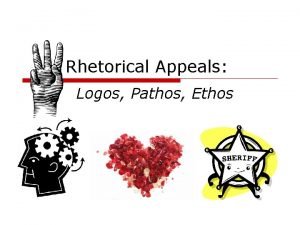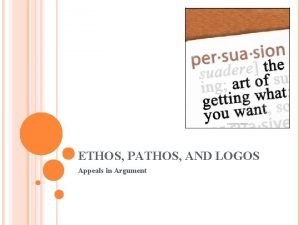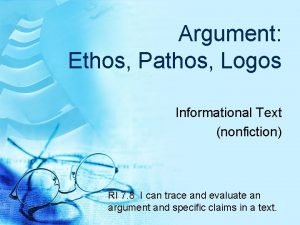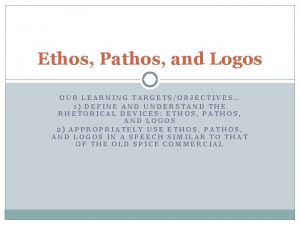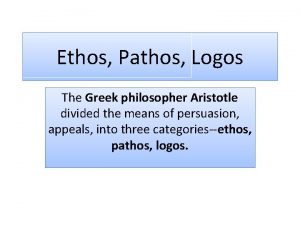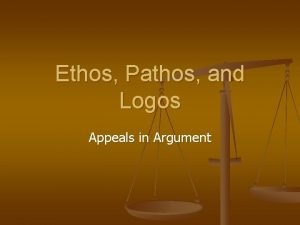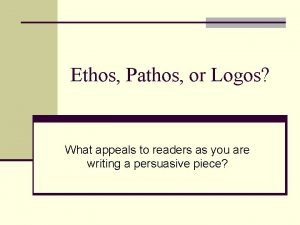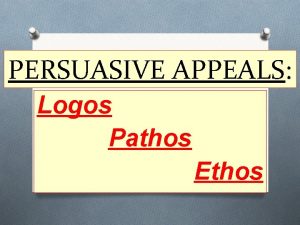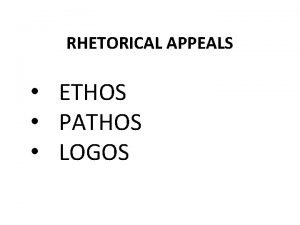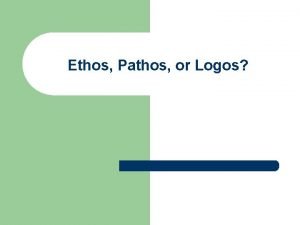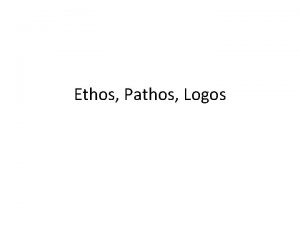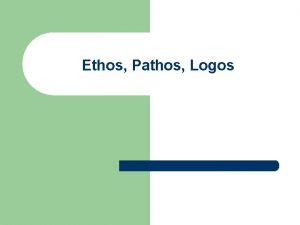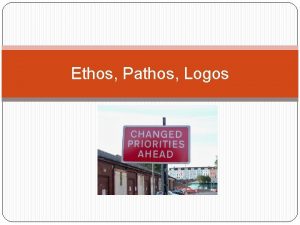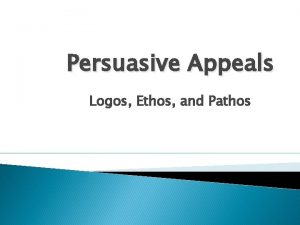Ethos Logos Pathos Review of Rhetorical Appeals What










- Slides: 10

Ethos, Logos, Pathos, Review of Rhetorical Appeals

What is Rhetoric? • Rhetoric (n) - the art of speaking or writing effectively (Webster's Definition). • According to Aristotle, rhetoric is "the ability, in each particular case, to see the available means of persuasion. " He described four main forms of rhetoric: Ethos, Logos, Pathos, and Kairos. • In order to be a more effective writer, you must understand these terms. When you better understand their meanings, your writing becomes more persuasive.


Ethos (Greek for “character”) § Ethos: the source's credibility / authority § Is the source trustworthy, educated, reliable, credible, honest, fair, and respectable? § Examples: § Client testimonials § Success stories § Celebrity endorsements § Personal anecdotes


Logos (Greek for “word”) § Logos: the logic/reasoning used to support a claim; the facts and statistics used to help support the argument § Examples: § Case studies § Cause and effect reasoning § Facts and statistics § Analogies

Logos Example: • Product: Cheerios • Logic: “Lower your cholesterol 4% in 6 weeks!”

Pathos (Greek for “suffering” or “experience”) § Pathos: appeals to the audience’s capacity for empathy; wants you to care about the subject matter § Typical Emotional Appeals: § Love § Pity § Patriotism § Hope § Jealousy § Anger § Fear


Other Important Essay Terms • The hook is an opening that grabs the reader’s attention and establishes a connection between the reader and the writer. • • • Fact Statistic Quote Story Paint a picture Question • The thesis is the author’s main idea stated clearly. It is often at the end of the introduction. • Subclaims are reasons why thesis is true. • Evidence refers to facts, statistics, studies, statements that are quoted by the author to support their argument. • Credibility means that the evidence comes from a reliable and trustworthy source. • Reasoning is commentary—generally after a piece of evidence—that connects to the claim. This is where an author makes rhetorical appeals and elaborates on their Rhetorical Appeals • Pathos, or emotional appeals, attempt to persuade the reader or listener by appealing to the senses and emotions. • Ethos are ethical appeals that attempt to persuade the reader or listener by focusing on the qualifications or the character of the speaker or by claiming that “it” is the ethical “thing” to do. • Logos, or logical appeals, attempt to persuade readers or listeners by leading them down the road of logic and causing them to come to their own conclusions. Logical appeals state the facts and show the facts are interrelated. • Kairos is the attempt to convince the audience that the issue is so important that they must act now.
 What greek philosopher named the appeals ethos pathos logos
What greek philosopher named the appeals ethos pathos logos Appeals ethos pathos logos
Appeals ethos pathos logos Persuasive techniques ethos
Persuasive techniques ethos Ethos logos pathos triangle
Ethos logos pathos triangle Ethos pathos logos in everyday life
Ethos pathos logos in everyday life Define ethos pathos and logos
Define ethos pathos and logos Greek philosophy ethos pathos logos
Greek philosophy ethos pathos logos Ethos pathos logos
Ethos pathos logos Pathos?
Pathos? Inclusive language rhetorical device
Inclusive language rhetorical device Ethos
Ethos
